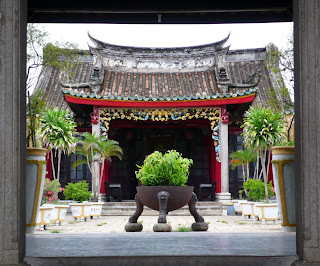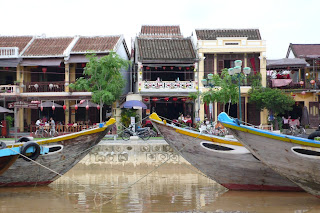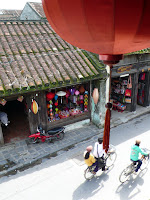Central Vietnam
Hue and Da Nang
 |
| Noon Gate at the Hue Citadel - the former 'Imperial City' |
From Hanoi, we traveled south (via overnight train dubbed the "
Reunification Express") into central Vietnam, a region of the country that promised some of the most amazing cultural sights. We weren't disappointed. Our first stop was in
Hue, the former capital of Vietnam under the
Nguyen Dynasties who ruled from around the 17th to 19th centuries. During their reign, they built massive temples, imposing government complexes, beautiful palaces, spectator arenas and (to further commemorate their existence) spectacular tombs. All of these are spread across the landscape around Hue, just waiting to be explored.
 |
| The Hue Arena, where Nguyen Emperors would stage fights between elephants and tigers. |
Like so many other places in Vietnam, this is also an
UNESCO World Heritage Site which is an indication of its tremendous importance. Regrettably, recent history hasn't been very good to the city or its monuments. Hue is located directly in the center of Vietnam, which was very close to the
demilitarized zone during the
Vietnam-America War. During the
Tet Offensive, Hue was the site of intense fighting and massive bombing, and much of the city was in ruin by the time it was over. Despite this, an amazing array of buildings survived - and Vietnam is making every effort to protect (and restore, in at least some cases) what is left.
 |
Riding a Dragon Boat down the Perfume River (Suong Huong) to see the Royal Tombs
|
Royal Tombs of Hue.
Six
royal tombs are scattered around the outskirts of Hue on both sides of the Perfume River. They are monuments to nine of the thirteen rulers of the Nguyen Dynasty. Most were designed by the intended occupant himself, and built during their lifetime. At least one was used as a 'summer home' for the Imperial family. We visited the tombs of Minh Mang, Tu Duc and Khai Dinh.
 |
While in Hue, we visited crafts shops where they made joss sticks (incense) for the temples.
Click here to watch a video of it being done. |
From Hue, we continued on to the city of
Da Nang. This place is probably most famous among Americans as the location of "China Beach" (called My Khe beach by the Vietnamese) which was an R&R spot for American soldiers during the War (and later a
television series with the same name). We did in fact go swimming at China Beach (the waves were
really rough!) but the main reason for visiting Da Nang was actually to see the
Marble Mountains and the
Museum of Cham Sculpture, both of which were really terrific.
+Photo.jpg) |
The Museum of Cham Sculpture is a must-see for anyone interested in the ancient civilizations of Vietnam.
NOTE: Photo from TripAdvisor, because I hadn't uploaded my Da Nang pics yet! |
It takes a bit of extra effort (and time) to stop in Da Nang. Many people just skip it, and I'm glad we didn't. The museum turned out to be especially important since we would be visiting actual Cham ruins later in our trip, and it really helped us put it all in context. They have an amazing collection of Cham sculpture at the museum, most of which was fortuitously collected prior to successive wars that resulted in massive destruction of the actual sites. If not for the pieces being collected, they would have been lost. Sensing a re-occurring theme here?
Next stop: Hoi An and the ancient Cham ruins at My Son! |





























+Photo.jpg)
















